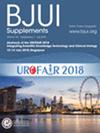Global viewpoints: evolving epidemiology and treatment patterns of prostate cancer in Asia
IF 4.4
2区 医学
Q1 UROLOGY & NEPHROLOGY
引用次数: 0
Abstract
ObjectivesThere are notable regional differences in the incidence and mortality of prostate cancer (PCa), whose underlying causes are arguably complex and multifactorial. In this review, we analysed the epidemiology, clinical characteristics, efficacy and safety of therapeutic drugs, prevalence of treatment and testing, and trends in PCa survival in Asian Urological Association member countries.MethodsTo investigate regional differences in incidence, mortality, and survival, we used the latest data from the GLOBOCAN 2022 edition, CONCORD‐3 study data, and the International Monetary Fund database.ResultsAsian men tend to present with more aggressive forms of PCa than their Caucasian counterparts. Paradoxically, survival outcomes are often better in Asian populations despite their more aggressive disease profiles. According to the GLOBOCAN 2022 data, PCa incidence is the highest in North America, Oceania, and Europe, but the lowest in incidence and mortality in Asian countries, despite varying significantly across these countries. Many developing Asian countries continue to experience rising mortality rates from PCa, largely due to limited access to PCa screening and disparities in healthcare infrastructure. While PCa treatments demonstrate comparable effectiveness in Asian populations to that in global trials, access to these therapies remains highly variable across the Asia–Pacific region, highlighting the need for access to improved healthcare policies and systems. In developing Asian nations, the 5‐year survival rate (5Y‐SR) is shown to be positively correlated with gross domestic product (GDP) per capita, suggesting that economic factors play a key determinant in PCa outcomes in these regions.ConclusionsOur analysis reveals stark disparities between developed and developing Asian countries, particularly in mortality‐to‐incidence ratios, prostate‐specific antigen screening coverage, access to novel therapeutics, and reimbursement policies. Despite medical advances, economic status and health policy infrastructure remain key determinants of PCa outcomes in Asia. Moreover, our analysis of 5Y‐SR relative to GDP per capita underscores the colossal impact of the latter on PCa prognosis.全球视角:亚洲前列腺癌流行病学和治疗模式的演变
目的前列腺癌(PCa)的发病率和死亡率存在显著的地区差异,其根本原因可以说是复杂和多因素的。在这篇综述中,我们分析了亚洲泌尿外科协会成员国前列腺癌的流行病学、临床特征、治疗药物的有效性和安全性、治疗和检测的流行程度以及前列腺癌的生存趋势。方法为了研究发病率、死亡率和生存率的地区差异,我们使用了GLOBOCAN 2022版、CONCORD‐3研究数据和国际货币基金组织数据库的最新数据。结果与白种人相比,亚洲男性的前列腺癌表现出更强的侵袭性。矛盾的是,亚洲人群的生存结果往往更好,尽管他们的疾病更具侵袭性。根据GLOBOCAN 2022数据,PCa发病率在北美、大洋洲和欧洲最高,但亚洲国家的发病率和死亡率最低,尽管这些国家之间存在显著差异。许多亚洲发展中国家的前列腺癌死亡率持续上升,这主要是由于前列腺癌筛查的机会有限以及医疗基础设施的差异。虽然PCa治疗在亚洲人群中显示出与全球试验相当的有效性,但在亚太地区,这些治疗的可及性仍然存在很大差异,这突出了改善医疗政策和系统的必要性。在亚洲发展中国家,5年生存率(5Y - SR)与人均国内生产总值(GDP)呈正相关,这表明经济因素在这些地区的PCa结果中起着关键的决定作用。我们的分析揭示了亚洲发达国家和发展中国家之间的明显差异,特别是在死亡率与发病率比、前列腺特异性抗原筛查覆盖率、新疗法的可及性和报销政策方面。尽管医疗进步,但经济状况和卫生政策基础设施仍然是亚洲PCa结果的关键决定因素。此外,我们对5Y - SR相对于人均GDP的分析强调了后者对PCa预后的巨大影响。
本文章由计算机程序翻译,如有差异,请以英文原文为准。
求助全文
约1分钟内获得全文
求助全文
来源期刊

BJU International
医学-泌尿学与肾脏学
CiteScore
9.10
自引率
4.40%
发文量
262
审稿时长
1 months
期刊介绍:
BJUI is one of the most highly respected medical journals in the world, with a truly international range of published papers and appeal. Every issue gives invaluable practical information in the form of original articles, reviews, comments, surgical education articles, and translational science articles in the field of urology. BJUI employs topical sections, and is in full colour, making it easier to browse or search for something specific.
 求助内容:
求助内容: 应助结果提醒方式:
应助结果提醒方式:


